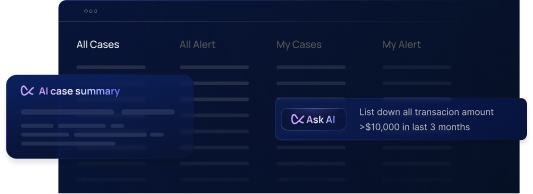Stablecoin businesses must operate with bank-level compliance rigor to meet new regulatory expectations. This heightened scrutiny isn’t limited to the U.S. In Singapore, the Monetary Authority of Singapore (MAS) now requires digital asset service providers (including stablecoin issuers and exchanges) to implement continuous AML monitoring and real-time oversight of transactions. European regulators are likewise raising the bar. The European Banking Authority’s guidance urges a risk-based approach where high-risk transactions, whether fiat or crypto, are flagged and reviewed in real time. Meanwhile, global watchdog FATF warns that the mass adoption of stablecoins could amplify illicit finance risks if AML controls are not uniformly applied. In fact, most on-chain illicit activity now involves stablecoins, underscoring why regulators demand that stablecoin firms monitor and enforce AML controls on off-chain fiat flows as rigorously as on-chain flows.
At the same time, mainstream financial players are embracing stablecoins for payments. Mastercard and Visa now facilitate stablecoin settlements, and even major banks have begun issuing their own stablecoins. Fintechs are building hybrid payment platforms bridging fiat and stablecoin rails, letting users transact in USD or USDC interchangeably. This convergence promises speed and efficiency, but it doubles the compliance complexity for financial institutions.
A stablecoin company enabling cash in/out via bank transfers, cards, wires, or faster payment schemes faces risks on both sides. Without robust fiat-side monitoring, money laundering or fraud can slip through the fiat off-ramps even if on-chain activity is being watched. In summary, stablecoin issuers and crypto payment companies must treat fiat transaction monitoring as mission-critical. They are now expected by regulators to have the same real-time AML oversight on fiat channels as they do on crypto, closing any gaps that could be exploited by bad actors.
Common Fiat-Layer Risks in Stablecoin Operations
Operating a stablecoin or crypto platform with fiat on/off-ramps introduces a host of traditional banking risks that must be managed alongside on-chain risks. Key fiat-layer threats include:
- Money Mule Accounts: Criminals may recruit “money mules”, individuals or accounts used to move illicit funds, to deposit or withdraw money through bank accounts linked to stablecoin platforms. This risk is exacerbated by instant payment networks and digital onboarding. In fact, banks report surges in mule activity using fast payment rails and crypto conversions to bypass outdated AML controls. Money mule schemes exploit the speed of real-time transfers, funneling funds through mule accounts within seconds before detection systems can react. Traditional AML systems often prove too slow, as the EY study notes they fail to catch mule transactions that move cross-border in seconds. Regulators like Switzerland’s FINMA have responded by calling for enhanced real-time monitoring to spot mule transactions as they occur.
- Layering via Fiat Off-Ramps: A common money laundering tactic is “layering”, obfuscating the trail of illicit funds by moving them through multiple accounts or asset types. Stablecoin businesses can inadvertently facilitate layering if they don’t monitor fiat conversions closely. For example, criminals might convert illicit crypto proceeds into stablecoins, then cash out via bank withdrawals in another jurisdiction. EY analysts have observed exactly this pattern: illicit crypto funds transformed into stablecoins, then redeemed back into fiat in secondary bank accounts, making the original source almost impossible to trace. Without unified oversight, these fiat off-ramp transactions might appear unrelated to the on-chain activity, allowing dirty money to slip through.
- Real-Time Payment Abuse: The rise of instant payment schemes (SEPA Instant, Faster Payments, etc.) means that fiat funds can move nearly as fast as crypto. This speed is a double-edged sword. Fraudsters exploit real-time payments to move funds quickly before any manual intervention can occur. Regulatory reports indicate fraud rates in instant payment networks are up to 10 times higher than in traditional batch payment systems, due to criminals leveraging the zero-delay environment to rapidly layer and dissipate funds. A stablecoin platform that lets users top-up or withdraw via instant bank transfers could be targeted by such schemes. If a stolen bank account or hacked fintech wallet is used to buy stablecoins, the thief can transfer the stablecoins out and cash them elsewhere all in minutes. Without real-time monitoring, by the time a suspicious pattern is flagged, the funds may be long gone.
- Card Top-Up and Bank Transfer Fraud: Another fiat-side risk is fraud via payment instruments used to fund accounts. For instance, a stablecoin service that accepts debit/credit card deposits or bank transfers faces exposure to stolen cards, identity fraud, and chargeback schemes. A bad actor might use a stolen credit card to purchase stablecoins (or load a fiat wallet that can convert to crypto), then route the crypto through mixers or exchanges. When the victim reports the fraud, the platform is left dealing with a chargeback and potentially unwittingly laundered funds. Similarly, fraudsters may use compromised bank accounts to deposit into crypto platforms and then quickly transfer value out. These scenarios require robust monitoring of deposit velocity, unusual funding sources, and mismatches (like many cards funding one account or a bank transfer from an unrelated party). Real-time rules to flag such anomalies on fiat ingress can prevent fraudulent funds from entering the system in the first place. Firms that treat fiat rails as a blind spot risk serious fraud losses and regulatory backlash for failing to prevent obvious red flags at the point of deposit.
Stablecoin companies that ignore these fiat-channel risks do so at their peril. Regulators have made clear that AML controls must cover both rails comprehensively, suspicious patterns like structuring or rapid layering of funds should be detected across fiat and crypto channels alike. Just as on-chain analytics can reveal risky wallet behavior, off-chain monitoring of bank and card transactions is essential to catch things like mule account activity, structuring of deposits, or stolen funds moving through. In short, a stablecoin business needs to be as vigilant with euros, dollars, and credit card payments as it is with USDC or USDT transfers.
Where Legacy and Crypto-Only Tools Fall Short
Many stablecoin issuers and crypto-fintechs find themselves cobbling together compliance tools originally built for a single realm (either traditional fiat banking or crypto only). This piecemeal approach often leaves dangerous gaps:
- Siloed Systems & Blind Spots: It’s common to see one system monitoring on-chain crypto transactions and a completely separate system (or manual process) monitoring fiat bank transactions. The result is fragmented rule sets and case queues for each rail. Compliance teams end up juggling disconnected alerts, and there’s no single view of a customer’s activity. Imagine that a user who rapidly moves funds between bank accounts and crypto wallets might trigger separate alerts in different systems, which never get linked. Or worse, one side of the activity might not trigger at all because the fiat tool isn’t tuned to look for patterns involving crypto. This siloed approach risks both false negatives (illicit activity slipping through cracks between systems) and duplicate alerts that waste time. Inconsistent oversight is exactly what regulators caution against.
- Slow, Rules-Only Monitoring: Traditional bank AML software, often deployed at legacy institutions, tends to rely on rigid, predefined rules and after-the-fact batch processing. For example, many banks still generate AML alerts overnight, reviewing transactions in aggregate at day’s end. Such delays are untenable when money moves in milliseconds. Criminals have learned to exploit the predictable thresholds of these systems (e.g. structuring just under a $10k rule) and the fact that nothing stops a fraudulent instant payment in flight. The inefficiency is glaring: roughly 90% of alerts generated by legacy rule-based systems are false positives, according to industry studies. Compliance teams drown in low-quality alerts while truly suspicious patterns (like rapid micro-transfers by “smurfs”) may go unnoticed amidst the noise. Simply put, yesterday’s tools can’t keep up with today’s fast-moving, clever criminals.
- Lack of Crypto Context in Bank Tools: Legacy AML platforms were built with bank transactions in mind, they often lack any awareness of blockchain addresses, crypto wallets, or exchange activity. They won’t, for instance, flag that a wire transfer is going to a crypto exchange known for lax KYC, or that a bank account receiving a large fiat withdrawal just sold a huge amount of stablecoin on-chain. This lack of on-chain intelligence means legacy tools miss risk indicators that are obvious in a crypto context. Conversely, many crypto-native compliance tools (like blockchain analytics services) focus on on-chain data but have little support for ingesting fiat payment data from core banking systems, cards, etc. A purely on-chain tool might rate a withdrawal as low risk if the wallet is clean, completely blind to the fact that the cash-out is going to, say, a high-risk jurisdiction via SWIFT or an account with fraud red flags. Neither approach alone gives a complete picture; without integration, neither can spot cross-rail typologies such as someone using a mule bank account to on-ramp dirty money into crypto.
- Insufficient Agility and Auditability: Another limitation of old-school systems is inflexibility. Tuning legacy AML rules or adding a new scenario (say, a rule for rapid stablecoin-to-fiat liquidations) often requires code changes or vendor support, taking weeks or months. In a dynamic risk environment and amid evolving regulations, this simply doesn’t work. Compliance teams need to be able to adjust thresholds or create a new rule in hours, not wait for the next quarterly software update. Moreover, many traditional systems lack robust audit trails for rule changes or case handling. Institutions have found themselves unable to answer regulators’ questions like “why was this alert generated?” or “who approved turning off this rule?” because their tools don’t log such details comprehensively. In fact, auditability is a common pain point: older solutions struggle to provide clear logs of configuration changes and alert decisions. Similarly, some newer crypto compliance tools (e.g. black-box AI risk scorers) can raise regulator concerns due to lack of explainability or change logs. An ideal platform for a regulated stablecoin firm must marry agility with governance, allowing fast changes, but also logging every change with version control, approvals, and QA checks. Without these, companies either move too slowly or introduce operational risk by making ad-hoc changes without oversight.
In summary, legacy bank AML tools are too slow, siloed, and “dumb” in the face of crypto-related patterns, while crypto-only tools often ignore the fiat side and lack enterprise-grade controls. This gap is exactly where modern regtech solutions are focusing innovation.
Flagright: Unified, Real-Time Transaction Monitoring & AML Compliance for Fiat and Stablecoin Rails
Flagright distinguishes itself as a next-generation transaction monitoring platform built to bridge the fiat–crypto compliance gap. It brings together the strengths of bank-grade AML systems and crypto-native intelligence, without the weaknesses of either. Here’s how Flagright addresses the challenges and requirements we’ve discussed:
Unified Monitoring & Single Source of Truth
Flagright is designed as an off-chain native AML platform that unifies compliance oversight across both fiat and stablecoin rails. Rather than maintaining parallel rulebooks and systems, stablecoin companies can use Flagright as a single monitoring engine and alert dashboard for all transaction types. A €10,000 SEPA bank transfer and a 10,000 USDC on-chain transfer will flow into the same system and be evaluated under a consistent risk model. The platform ingests off-chain data in real time, e.g. card swipes, ACH or SWIFT bank transfers, wire deposits, alongside on-chain events like stablecoin movements. By integrating with leading blockchain analytics providers, Flagright enriches fiat transaction alerts with on-chain context (and vice versa).
What does this mean in practice? Suspicious behavior that spans fiat and crypto can be detected as a single pattern rather than fragmented clues. For example, if a user rapidly moves funds from their bank account into crypto wallets and then to an exchange, Flagright sees the whole sequence and generates one alert with the full context. Investigators can then review the bank transactions and the crypto transactions side by side in one case, with one unified workflow. There’s no need to toggle between different tools or manually correlate data, saving time and ensuring nothing is overlooked. Every action (alerts, investigations, rule changes) is also logged in one place for a complete audit trail. This unified approach eliminates duplicate alerts and blind spots, yielding far stronger oversight. In fact, financial institutions that replaced siloed monitoring with Flagright saw dramatic improvements, 93% fewer false positive alerts and major cost savings, thanks to the shared intelligence between fiat and crypto monitoring. By consolidating compliance into one platform, stablecoin companies can finally attain the “single source of truth” regulators expect for financial crime risk across all assets.
Real-Time Detection with High Performance
Speed is a core feature of Flagright’s platform. Unlike legacy systems that run checks hours or days after the fact, Flagright enables real-time transaction monitoring on both fiat and crypto events. Its cloud-based rule engine evaluates transactions with sub-second response times on average. That means an incoming card payment, ACH transfer, or stablecoin blockchain transfer can be screened immediately as it occurs, without introducing user friction. An alert for a suspicious pattern can pop up while the funds are still in motion, allowing potential interdiction or immediate investigation. This is exactly the capability regulators and industry experts have been urging; “dynamic AML transaction monitoring capable of identifying suspicious patterns in real time”, and Flagright delivers it out of the box.
Under the hood, Flagright’s infrastructure is built for performance and reliability. The platform boasts 99.99% uptime globally, ensuring that compliance controls aren’t left blind during peak trading or payment periods. High throughput stablecoin issuers (processing thousands of transactions per second) benefit from this resilience – even if crypto markets surge or payment volumes spike, the monitoring keeps pace. Real-time coverage is paired with the ability to run post-event analytics on historical data in the same system. Compliance teams can do retrospective reviews (e.g. aggregating a week of activity to spot longer-term patterns) using Flagright’s interface, complementing the instant alerts. This dual capability, instantaneous detection plus retroactive analysis, exemplifies the “always-on” vigilance regulators are increasingly expecting. In short, Flagright’s high-performance engine allows stablecoin firms to catch fast-moving threats (like rapid mule transactions) and slow-burning schemes alike, all without the latency or downtime issues of older platforms.
Adaptive Rules and Behavior Analytics
One of Flagright’s most powerful features is its AI-native approach to rule setting and anomaly detection. Compliance teams using Flagright aren’t stuck with rigid one-size-fits-all thresholds. The platform offers a no-code rule builder with an extensive library of pre-built scenarios, which can be customized in minutes via an intuitive interface. This agility means if a new typology emerges (say, a novel layering technique or a regulatory change requiring a new check), the team can deploy a rule or adjust a threshold almost immediately, no coding or vendor ticket needed. Regulators have explicitly encouraged this kind of in-house agility, as it allows institutions to respond faster to evolving risks. Flagright’s no-code rules empower compliance officers to be self-sufficient and creative in fighting financial crime, rather than relying on slow IT processes.
Beyond ease of use, Flagright’s rule engine supports dynamic risk scoring and behavior-based analytics that dramatically reduce false positives. Instead of blunt static limits (e.g. “flag all transactions over $5,000”), Flagright can establish a tailored baseline for each customer’s normal activity. It uses statistical measures like medians, means, and standard deviations to learn what “normal” looks like for each user. Then it can automatically flag deviations from that norm. For example, if a retail customer typically makes $500 transfers a few times a week, and suddenly they start making twenty $5,000 transfers in a day, Flagright would detect that anomaly relative to their personal history. Conversely, a high-net-worth customer who regularly moves $50k will not be flagged by a generic $10k rule every time, only if they behave abnormally for them. By “learning” each user’s pattern, the system achieves a far better balance between sensitivity and specificity. Flagright rolled out automated anomaly detection rules (using these statistical baselines) in 2025, allowing compliance teams to enable pre-built dynamic rules that auto-adjust to each customer. The result has been significantly fewer false positives and greater ability to catch the real red flags. Indeed, layering in user-specific behavioral signals helps surface risks that wouldn’t be visible under uniform thresholds, while filtering out noise from legitimate high-value clients. This approach aligns perfectly with regulators’ expectations for a risk-based AML program, monitoring intensity is calibrated to each customer’s risk profile, rather than using blunt rules that treat every user the same.
Integrated Screening and Case Management
Another advantage of Flagright is its all-in-one design. The platform doesn’t just do transaction monitoring; it also includes integrated modules for sanctions screening, case management, and workflow automation. This means a stablecoin company can manage the entire compliance process in one place, from detection to investigation to reporting.
On the screening side, every transaction, whether a SWIFT wire, card payment, or on-chain transfer, can be automatically screened against sanctions and watchlists in real time. This is critical because regulators insist that sanctions screening cover all transfers, crypto or fiat. Flagright’s screening engine can leverage third-party data and APIs to check names, IBANs, wallet addresses, etc., against the latest sanctions lists (OFAC, UN, EU, etc.) and even custom watchlists. Importantly, Flagright uses intelligent matching to minimize false hits (e.g. catching variant spellings or fuzzy matches of blacklisted names without flagging innocent partial matches). As new sanctions or enforcement lists are released, the system updates automatically, a crucial capability given the fast-evolving sanctions landscape in the crypto space. By blocking illicit addresses or flagged individuals in real time, stablecoin businesses using Flagright can more confidently prevent sanctioned actors from transacting on their platform.
On the back end, case management is deeply woven into Flagright’s platform. All alerts, whether triggered by fiat rules or crypto rules, funnel into a unified alert inbox and case queue. Analysts have one centralized workspace to triage and investigate suspicious activity, instead of jumping between systems. As soon as an alert is generated, it can even be auto-marked “In Progress” or assigned to the right analyst team based on severity or type, ensuring immediate attention for high-risk cases (e.g. a large stablecoin transfer from a darknet-linked wallet might go straight to a Level 2 investigator). Within each case, Flagright provides rich documentation tools: analysts can attach evidence (like blockchain explorer screenshots, ID documents, chat logs) directly into the case file and add notes, with every action time-stamped and attributed. This creates a thorough audit trail of the investigation process itself, useful for both internal QA and regulator audits. Flagright’s case management also supports advanced workflows like linked entity views (to see relationships between a customer, their business accounts, beneficiaries, etc., all in one place), and even direct updates to customer profiles from the case screen (so if during an investigation you conclude a user should be marked high-risk or suspended, you can update that status right then and there).
Quality assurance is another area where Flagright shines. The platform includes QA workflows and checklists to enforce investigative quality standards. For example, you can require that analysts complete a checklist (e.g. “Verify source of funds”, “Check ID matches account”) before closing an alert, and have a second reviewer sign off or leave comments on each item. Outcomes of QA reviews (pass/fail and feedback) are visible in the case, helping train analysts and ensure consistent standards. These kinds of features are typically absent in basic crypto AML tools, but they are essential in regulated environments to avoid mistakes and demonstrate due diligence.
In sum, Flagright provides end-to-end case management: from detection to investigation to SAR filing, all in one integrated system. Unified alert handling means nothing falls through the cracks, and robust workflows mean even as you empower the compliance team with speed, you maintain strict oversight and documentation. This comprehensive approach to screening and case management is geared to meet the needs of stablecoin compliance teams that may be dealing with high volumes of both fiat and crypto alerts, it helps them stay organized, efficient, and audit-ready at all times.
Audit Trails, Governance, and Controls for Regulators
Operating with bank-level compliance rigor means having strong internal governance. Flagright was built with this in mind, offering extensive auditability and control features not found in most crypto-oriented solutions. Every compliance decision and configuration in Flagright is fully auditable. The system maintains a comprehensive audit trail and version history of all policy configurations and rule changes. There’s a centralized repository where each change is logged along with who made it and when. If a regulator asks, “Why did this transaction trigger an alert?” or “How do you update your monitoring scenarios?”, the compliance team can easily pull records showing the exact logic that was in place at the time and the full change history leading up to it. This level of transparency is crucial for regulatory inspections, and many legacy systems struggle to provide it.
Flagright goes a step further by introducing built-in version control and approval workflows for critical changes. Any modification to a rule, risk model, or scoring parameter can be configured to require peer approval before going live. For instance, if someone tries to adjust the threshold on a high-risk scenario or change the weighting of a risk factor, a second compliance manager can be required to review and approve the change. This maker-checker control ensures no single analyst can, say, lower a risk threshold to hide activity or accidentally disable an important rule, without oversight. All changes and approvals are logged with comments explaining the rationale. Flagright essentially brings source control discipline to AML settings, you can even roll back to a previous rule version if a new change had unintended consequences.
Moreover, automated QA sampling can be set up to periodically review closed alerts for quality. Flagright’s AI can highlight inconsistencies in how analysts dispositioned alerts, helping supervisors catch any errors or retrain staff. The results of these QA checks are tracked and reported inside the platform. By tying together rule management, change approvals, QA, and audit logs, Flagright provides end-to-end governance over the AML program. This gives heads of compliance peace of mind that even as they move fast and empower analysts with self-service tools, they are not introducing control weaknesses. Rapid innovation in your AML approach is possible safely, because every change is controlled and documented.
These governance features are not just nice-to-have, they directly address regulator expectations. For example, regulators often ask for evidence of how you validate and update your transaction monitoring system. With Flagright, a stablecoin firm can produce a full audit trail of rule changes, the reason for each change, who approved it, and how the system has been fine-tuned over time. If a regulator inquires about a specific alert, you can show exactly which rule triggered and why (since Flagright’s alerts are always accompanied by an explanation of the triggering factors). This level of explainability, “every alert needs a why”, is built into the platform, in contrast to black-box AI systems that produce scores with no context. Flagright’s combination of AI and rules is deliberately transparent and explainable, making it far easier to earn regulatory trust. All told, for a stablecoin company operating under stringent oversight, Flagright offers the confidence that nothing is happening in your compliance program that isn’t tracked, justified, and under control.
Conclusion: Closing the Fiat Blind Spot in Stablecoin Compliance
As stablecoins move from the fringes of finance to the mainstream, the message from regulators is unequivocal: “same business, same risks, same rules.” Stablecoin issuers, crypto payment providers, and any fintech straddling fiat and crypto must implement compliance controls on par with traditional banks. This means real-time transaction monitoring, thorough KYC and sanctions screening, and robust AML governance across all rails, on-chain and off-chain. The fiat side of the business can no longer be treated as a blind spot. Criminals certainly won’t ignore it; in fact, they target the weakest link in the chain. Without modern fiat transaction monitoring, a stablecoin company could unwittingly become a conduit for money mule schemes, fraud, or sanctioned fund flows passing through bank accounts and cards.
The good news is that the regtech industry has risen to this challenge. Flagright represents a new breed of AML platform that allows stablecoin companies to strengthen their compliance posture holistically. By unifying crypto and fiat monitoring in real time, leveraging adaptive analytics, and embedding case management and audit controls, Flagright equips compliance teams to catch more illicit behavior while reducing false alarms. It bridges the long-standing gap between legacy bank tools and crypto-native tools, bringing the best of both worlds into one solution. With such a platform in place, stablecoin businesses can confidently meet regulatory expectations (from FATF’s standards to MAS guidelines to upcoming EU rules) and prove that no matter how a customer moves value, via bank wire or blockchain, the activity is being watched under a single, vigilant eye.
In a field where trust is paramount, being proactive about fiat-side AML is also just good business. It helps safeguard banking partnerships, prevent costly fraud losses, and protect the firm’s reputation. Compliance becomes a competitive advantage when done right. By deploying a solution like Flagright, stablecoin and crypto companies can ensure that risk isn’t slipping through the cracks on the fiat side. Instead, they gain a 360-degree view of customer behavior and can intercept threats at any point in the flow of funds. The result is a stronger, more resilient operation that can scale with confidence. Stablecoin innovation may be redefining finance, but with the right compliance infrastructure in place, we can keep both the crypto and the fiat rails safe from abuse, without sacrificing the speed and efficiency that make these new rails so powerful.




.svg)





















